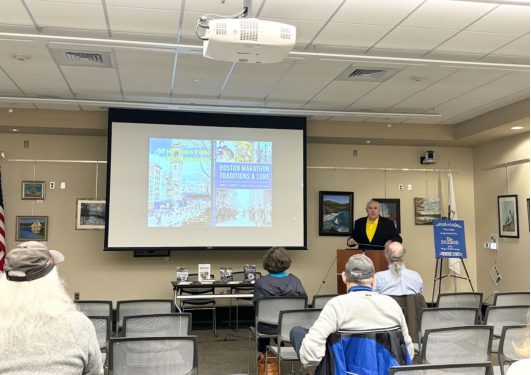By Madison Butkus
Hometown Weekly Reporter
With the 128th Boston Marathon coming up on Monday, April 15th, the Walpole Public Library (WPL) hosted local race enthusiast and author Paul Clerici to discuss his most recent book, “Boston Marathon Traditions and Lore”. This event was sponsored by the Friends of the Walpole Public Library. Clerici is also well known around Walpole as the Race Director of the Camy 5K Run & David 5K Walk.
Crowds of families and friends gathered together within the Community Room of the WPL on Wednesday, March 27th to learn all about the Boston Marathon traditions over the years. The WPL went on to write, “Paul Clerici will describe and illustrate such foot race traditions as the connection between the Greek god Zeus, the Battle of Marathon in 490 BC, and the gold-dipped olive-branch wreaths each champion receives; the growth of the start and finish lines from its simple origins as a single line to its lavish colorful artistry; the unique athlete and culture exchange program with the Ohme-Hochi 30K in Japan that began with four-time Boston Marathon winner Bill Rodgers in the 1970s; statues and monuments along the course, including one of runner-sculptor Bobbi Gibb, the first woman to finish the Boston Marathon and who created the life-size statue herself; the ever-changing beauty of the finisher medal; the evolution of media coverage; the athlete villages, one of which began in 1996 to accommodate its largest field of 38,000 for its centennial; and more.”
Throughout the entirety of his presentation, Clerici emphasized the significant relation between the Greek and Boston traditions within this marathon. One of these most notable relations is that of the laurel wreath being placed on the winner’s heads. This tradition was brought over from Greece in which Boston has been following it for the last decades. Bill Rogers had one of his wreaths encased to preserve it, while the other three were misplaced.
Overtime, the wreaths were made out of olive branches which ultimately made them a bit thinner and skinnier. In 2010, they started dipping them in gold, which is how we see them displayed to winners today.
Clerici shared with attendees that the finish line of the Boston Marathon can be seen year round. A few days after the marathon concludes, Boylston Street is shut down so that workers can come in and paint the finish line onto the ground. This allows this spot to be a tourist attraction in which anyone can come and view it at any time throughout the year. While Clerici is unsure if any other places do this, he stated that the Boston Marathon truly does focus on the details and takes pride in their marathon.
For more information about Paul Clerici and his books, please visit his website at www.paulclerici.com.























